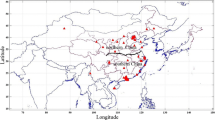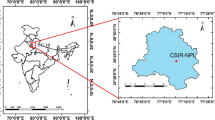Abstract
The seasonal variation of PM2.5 carbonaceous aerosol was investigated in Beijing and Tangshan cities of China. The characteristics of carbonaceous aerosol (e.g., organic carbon, OC and elemental carbon, EC) under different weather conditions and their source apportionment were also examined. The annual average PM2.5 concentration in the study area reached 95.6–197.3 μg/m3, showing seasonal and spatial variation. The carbonaceous materials accounted for 17.3–21.2 % of the PM2.5, and they had a much higher content under haze weather condition. It was found that the PM2.5 contained more OC than EC. Principal component analysis (PCA) results indicated that the carbonaceous components came from mixed emission sources of coal combustion, vehicle exhaust, and biomass burning. In Beijing, the vehicle emission made a contribution of 63.0 % to the carbonaceous components of PM2.5 in summer, which is higher than that in Tangshan. While in Tangshan, the coal combustion made a contribution of 30.3 %, which is much higher than that in Beijing.




Similar content being viewed by others
References
Bond, T. C., Streets, D. G., Yarber, K. F., Nelson, S. M., Woo, J. H., & Klimont, Z. (2004). A technology-based global inventory of black and organic carbon emissions from combustion. Journal of Geophysical Research-Atmospheres. doi:10.1029/JD003697.
Butler, A. J., Andrew, M. S., & Russell, A. G. (2003). Daily sampling of PM2.5 in Atlanta: results of the first year of the assessment of spatial aerosol composition in Atlanta study. Journal of Geophysical Research-Atmospheres. doi:10.1029/JD002234.
Cao, J. J., Wu, F., Chow, J. C., Lee, S. C., Li, Y., Chen, S. W., An, Z. S., Fung, K. K., Watson, J. G., Zhu, C. S., & Liu, S. X. (2005). Characterization and source apportionment of atmospheric organic and elemental carbon during fall and winter of 2003 in Xi’an, China. Atmospheric Chemistry and Physics, 5, 3127–3137.
Cao, J. J., Lee, S. C., Chow, J. C., Watson, J. G., Ho, K. F., Zhang, R. J., Jin, Z. D., Shen, Z. X., Chen, G. C., Kang, Y. M., Zou, S. C., Zhang, L. Z., Qi, S. H., Dai, M. H., Cheng, Y., & Hu, K. (2007). Spatial and seasonal distributions of carbonaceous aerosols over China. Journal of Geophysical Research-Atmospheres. doi:10.1029/JD008205.
Castro, L. M., Pio, C. A., Harrison, R. M., & Smith, D. J. T. (1999). Carbonaceous aerosol in urban and rural European atmospheres: estimation of secondary organic carbon concentrations. Atmospheric Environment, 33, 2771–2781.
Chen, Y. J., Zhi, G. R., Feng, Y. L., Fu, J. M., Feng, J. L., Sheng, G. Y., & Simoneit, B. R. T. (2006). Measurements of emission factors for primary carbonaceous particles from residential raw-coal combustion in China. Geophysical Research Letters. doi:10.1029/GL026966.
Cheng, S. Y., Lang, J. L., Zhou, Y., Han, L. H., Wang, G., & Chen, D. S. (2013). A new monitoring-simulation-source apportionment approach for investigating the vehicular emission contribution to the PM2.5 pollution in Beijing, China. Atmospheric Environment, 79, 308–316.
Choi, J. K., Heo, J. B., Ban, S. J., Yi, S. M., & Zoh, K. D. (2012). Chemical characteristics of PM2.5 aerosol in Incheon, Korea. Atmospheric Environment, 60, 583–592.
Chow, J.C., Watson, J.G., Lowenthal, D.H., Solomon, P.A., Magliano, K.L., Ziman, S.D., Richards, L.W., (1993). PM10and PM2.5compositions in california san Joaquin valley. Aerosol Science and Technology,18, 105-128.
Chow, J. C., Watson, J. G., Lu, Z. Q., Lowenthal, D. H., Frazier, C. A., Solomon, P. A., Thuillier, R. H., & Magliano, K. (1996). Descriptive analysis of PM2.5 and PM10 at regionally representative locations during SJVAQS/AUSPEX. Atmospheric Environment, 30, 2079–2112.
Chow, J. C., Watson, J. G., Chen, L. W. A., Arnott, W. P., Moosmuller, H., & Fung, K. (2004a). Equivalence of elemental carbon by thermal/optical reflectance and transmittance with different temperature protocols. Environmental Science & Technology, 38, 4414–4422.
Chow, J. C., Watson, J. G., Kuhns, H., Etyemezian, V., Lowenthal, D. H., Crow, D., Kohl, S. D., Engelbrecht, J. P., & Green, M. C. (2004b). Source profiles for industrial, mobile, and area sources in the Big Bend Regional Aerosol Visibility and Observational study. Chemosphere, 54, 185–208.
Feng, Y. L., Chen, Y. J., Guo, H., Zhi, G. R., Xiong, S. C., Li, J., Sheng, G. Y., & Fu, J. M. (2009). Characteristics of organic and elemental carbon in PM2.5 samples in Shanghai, China. Atmospheric Research, 92, 434–442.
Heo, J., Dulger, M., Olson, M. R., McGinnis, J. E., Shelton, B. R., Matsunaga, A., Sioutas, C., & Schauer, J. J. (2013). Source apportionments of PM2.5 organic carbon using molecular marker Positive Matrix Factorization and comparison of results from different receptor models. Atmospheric Environment, 73, 51–61.
Jiang, Y., Hou, X., Zhuang, G., Li, J., Wang, Q., Zhang, R., & Lin, Y. (2009). The sources and seasonal variations of organic compounds in PM2.5 in Beijing and Shanghai. Journal of Atmospheric Chemistry, 62, 175–192.
Lang, J., (2013). Study of regional emission sources classification and optimized reduction based on the total atmospheric pollutants quantity control. Ph.D. Thesis, Beijing University of Technology, Beijing, China, 128 pages (in Chinese).
Lang, J., Cheng, S., Wei, W., Zhou, Y., Wei, X., & Chen, D. (2012). A study on the trends of vehicular emissions in the Beijing-Tianjin-Hebei (BTH) region, China. Atmospheric Environment, 62, 605–614.
Lim, H. J., & Turpin, B. J. (2002). Origins of primary and secondary organic aerosol in Atlanta: results of time-resolved measurements during the Atlanta supersite experiment. Environmental Science & Technology, 36, 4489–4496.
Lin, P., Hu, M., Deng, Z., Slanina, J., Han, S., Kondo, Y., Takegawa, N., Miyazaki, Y., Zhao, Y., & Sugimoto, N. (2009). Seasonal and diurnal variations of organic carbon in PM2.5 in Beijing and the estimation of secondary organic carbon. Journal of Geophysical Research-Atmospheres. doi:10.1029/JD010902.
Lonati, G., Ozgen, S., & Giugliano, M. (2007). Primary and secondary carbonaceous species in PM2.5 samples in Milan (Italy. Atmospheric Environment, 41, 4599–4610.
Louie, P. K. K., Chow, J. C., Chen, L. W. A., Watson, J. G., Leung, G., & Sin, D. W. M. (2005). PM2.5 chemical composition in Hong Kong: urban and regional variations. Science of the Total Environment, 338, 267–281.
Mauderly, J. L., & Chow, J. C. (2008). Health effects of organic aerosols. Inhalation Toxicology, 20, 257–288.
MEP (Ministry of Environmental Protection, China), (2014). Airquality of keyareas and 74 cities in 2013. http://www.mep.gov.cn/gkml/hbb/qt/201403/t20140325_269648.htm. Accessed 20 May 2014 (in Chinese).
Niu, Z., Wang, S., Chen, J., Zhang, F., Chen, X., He, C., Lin, L., Yin, L., & Xu, L. (2013). Source contributions to carbonaceous species in PM2.5 and their uncertainty analysis at typical urban, peri-urban and background sites in southeast China. Environmental Pollution, 181, 107–114.
Pachauri, T., Satsangi, A., Singla, V., Lakhani, A., & Kumari, K. M. (2013). Characteristics and sources of carbonaceous aerosols in PM2.5 during wintertime in Agra, India. Aerosol and Air Quality Research, 13, 977–991.
Pachon, J. E., Balachandran, S., Hu, Y., Weber, R. J., Mulholland, J. A., & Russell, A. G. (2010). Comparison of SOC estimates and uncertainties from aerosol chemical composition and gas phase data in Atlanta. Atmospheric Environment, 44, 3907–3914.
Pathak, R. K., Wang, T., Ho, K. F., & Lee, S. C. (2011). Characteristics of summertime PM2.5 organic and elemental carbon in four major Chinese cities: implications of high acidity for water-soluble organic carbon (WSOC). Atmospheric Environment, 45, 318–325.
Plaza, J., Artinano, B., Salvador, P., Gomez-Moreno, F. J., Pujadas, M., & Pio, C. A. (2011). Short-term secondary organic carbon estimations with a modified OC/EC primary ratio method at a suburban site in Madrid (Spain). Atmospheric Environment, 45, 2496–2506.
Qiu, J. H., & Yang, L. Q. (2000). Variation characteristics of atmospheric aerosol optical depths and visibility in North China during 1980-1994. Atmospheric Environment, 34, 603–609.
Schauer, J. J., Kleeman, M. J., Cass, G. R., & Simoneit, B. R. T. (2002). Measurement of emissions from air pollution sources. 5. C-1-C-32 organic compounds from gasoline-powered motor vehicles. Environmental Science & Technology, 36, 1169–1180.
Sheehan, P. E., & Bowman, F. M. (2001). Estimated effects of temperature on secondary organic aerosol concentrations. Environmental Science & Technology, 35, 2129–2135.
Strader, R., Lurmann, F., & Pandis, S. N. (1999). Evaluation of secondary organic aerosol formation in winter. Atmospheric Environment, 33, 4849–4863.
Turpin, B. J., & Huntzicker, J. J. (1991). Secondary formation of organic aerosol in the Los Angeles basin—a description analysis of organic and elemental carbon concentrations. Atmospheric Environment Part a-General Topics, 25, 207–215.
Viana, M., Maenhaut, W., ten Brink, H. M., Chi, X., Weijers, E., Querol, X., Alastuey, A., Mikuska, P., & Vecera, Z. (2007). Comparative analysis of organic and elemental carbon concentrations in carbonaceous aerosols in three European cities. Atmospheric Environment, 41, 5972–5983.
Viidanoja, J., Sillanpaa, M., Laakia, J., Kerminen, V. M., Hillamo, R., Aarnio, P., & Koskentalo, T. (2002). Organic and black carbon in PM2.5 and PM10: 1 year of data from an urban site in Helsinki, Finland. Atmospheric Environment, 36, 3183–3193.
Wang, F., (2010). Study on the transboundary atmospheric transport and identification of sensitive emission sources. Ph.D. Thesis, Beijing University of Technology, Beijing, China, 136 pages (in Chinese).
Ward, T. J., & Lincoln, E. (2006). Concentrations of PM2.5-associated OC, EC, and PCDD/Fs measured during the 2003 wildfire season in Missoula, Montana. Environmental Monitoring and Assessment, 115, 39–50.
Yu, J. Z., Tung, J. W. T., Wu, A. W. M., Lau, A. K. H., Louie, P. K. K., & Fung, J. C. H. (2004). Abundance and seasonal characteristics of elemental and organic carbon in Hong Kong PM10. Atmospheric Environment, 38, 1511–1521.
Zhang, Y., Shao, M., Zhang, Y.-H., Zeng, L.-M., He, L.-Y., Zhu, B., Wei, Y.-I., & Zhu, X.-L. (2007). Source profiles of particulate organic matters emitted from cereal straw burnings. Journal of Environmental Sciences-China, 19, 167–175.
Zhao, P., Dong, F., Yang, Y., He, D., Zhao, X., Zhang, W., Yao, Q., & Liu, H. (2013). Characteristics of carbonaceous aerosol in the region of Beijing, Tianjin, and Hebei, China. Atmospheric Environment, 71, 389–398.
Acknowledgments
This work was supported by the Natural Sciences Foundation of China (No. 51038001) and the Beijing Municipal Commission of Science and Technology (No. Z131110002813116 & No. Z141108001314048). The authors greatly appreciated the Beijing Municipal Commission of Education and Beijing Municipal Commission of Science and Technology for supporting this work. The authors are also grateful to the anonymous reviewers for their insightful comments.
Author information
Authors and Affiliations
Corresponding authors
Rights and permissions
About this article
Cite this article
Wang, G., Cheng, S., Li, J. et al. Source apportionment and seasonal variation of PM2.5 carbonaceous aerosol in the Beijing-Tianjin-Hebei Region of China. Environ Monit Assess 187, 143 (2015). https://doi.org/10.1007/s10661-015-4288-x
Received:
Accepted:
Published:
DOI: https://doi.org/10.1007/s10661-015-4288-x




